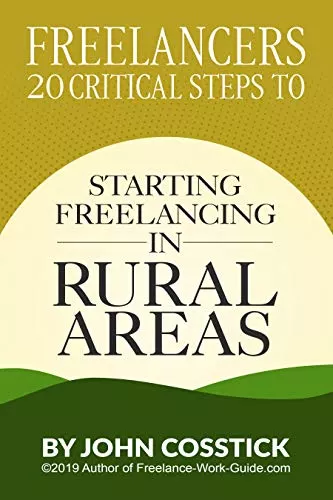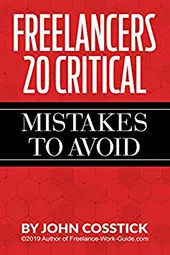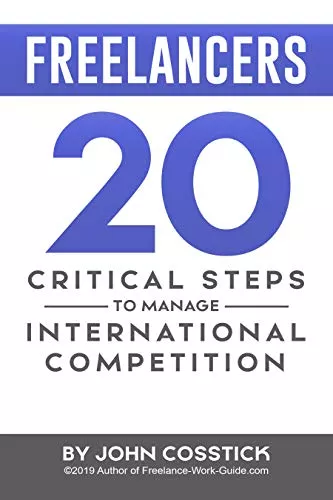Search engine rankings are an essential part of any business’ strategy. Since SEO became one of the most important facets of success a couple of years ago, no company can afford to omit it from their plan.
Right now, the domain authority stands out as a critical factor that you can’t overlook. After all, the higher a website’s authority, the better the search engine rankings, and the more traffic it will get in the long-term.
Therefore Freelancers working with a client’s website’s content management need to know the top 20 ways freelancers can build a business client’s website authority.
As an organisation that guarantees domain authority success, it’s your job to ensure your clients benefit from the best practices. However, it’s tough to know which elements to choose because there are so many. And, some work and others aren’t as effective.
In this guide, we’ll outline the 20 most influential ways to build a business client’s website authority.
1. Identify Your Goals

As always, the first step is to figure out the client’s goals. Once you know them, you can start crafting a strategy to help them hit their targets. Also, you should tailor the best practices to each specific goal.
If, for example, you’re looking to broaden their reader base and open new opportunities, using guest writers is the right option. However, if traffic is the main concern, then SEO is the perfect partner.
Write down your goals and refer to them regularly so that you don’t go off-piste.
2. Choose An Excellent Domain Name

Your client’s domain name is an excellent opportunity to boost their website’s authority by optimising the URL. Pick a name that’s relevant to the brand and that includes a keyword to ensure the site pops up every time Google authorises a search. Another great tip is to make it easy to remember.
People won’t come back to a site if they struggle to recall the domain name, which will lower the website’s authority as search engine hits and traffic will decline.
3. Optimise The Content

SEO is a powerful content marketing tool because it’s flexible. Not only does it work for SERPS, but it’s also great at enhancing the authority of a domain or website.
The key is to optimise the code, such as the tags, metatags, and any other metadata. This stuff might be small, yet it packs a punch. Image tags are perfect examples.
Be sure to mix up the keywords and phrases within the body of the text. As well as the main search words that you’ve identified, you need to use relevant variations as supplements.
Long-tail versions work well as they are optimised without being spammy. If you use links, keep them short and sweet so that they look natural.
4. Research Keywords And Phrases

Search engine optimisation only works if the keywords and phrases are correct. The ones that aren’t a waste of time, money and energy as they won’t rank highly whatsoever. Research is the only way to find the main keywords as well as the supplementary ones that search engines love.
Start by identifying the topics and filling in the gaps in with content marketing terms. To differentiate your client’s keywords from the competition, search for related terms. By inputting the ones, you already have into Google, you’ll be able to see similar words that are popular.
5. Create Unique Content

Shareable copy is a must as it will encourage other sites to link it and create backlinks. Once this happens, your client’s website authority will skyrocket as it’s a reference point for competitors, audiences and social media influencers alike.
Always try and stand out from the crowd by being original. If you’re writing about a subject that’s old and tired, think of a new and exciting angle and come up with a clickable title. Make sure anyone who wants to share it doesn’t find it difficult by providing social media widgets and embed code.
6. Remember Internal Linking
Although backlinks are vital, there’s no excuse for forgetting about internal links. They direct people who land on the site where they want to go and make info easy to find with one click. In short, internal links enhance the user experience, which is a significant part of a site’s domain authority.
Where possible, optimise your content with a link back to the homepage or any relevant, internal page. A cool trick is to link to blog posts and articles that speak about or mention similar topics.
7. And Root Domains
It’s not all about how many backlinks you get – it’s about variety. If you have ten links from two different sites, it’s not as effective as having two from five websites. Having several root domains is better than having one or two even if the number of links is high.
Focus on broadening your scope so that you get backlinks from more root domains.
8. Piggyback Off Trusted Links

Certain websites demand respect, such as Forbes and Entrepreneur. However, it doesn’t mean they are fully trusted. Moz, the entity that ranks domain authority, only trusts links with the domain .edu or .gov. Although they are hard to backlink directly, you can use backlinks from other sites.
Moz still scores platforms highly even if there is an element of separation. It’s recognition by proxy, and it’s an excellent loophole if you can’t get government sites to play ball.
9. Get Guest Writers

Guest writers bring their audiences with them, which only benefits the site that hosts their content. With a guest post, there’s more chance of connecting and interacting with new readers and potential customers. Aside from the backlinks, it’s a fantastic way to produce quality, shareable content that’s SEO-optimised and original.
Of course, you can’t ask any writer. To ensure they are right for the job, think about your goals.
- Why do you want guest posts?
- What type of contributions are you looking for?
- Do you need popular posts or factual ones?
Answering these questions will help you decide whether you need experienced bloggers or excellent writers within a broad or niche topic. You might need to pay them if they are in-demand and want more than a byline.
10. But Don’t Give Them Control

Guest contributors tend to want access to the site so that they can post and ensure their article goes live. But you shouldn’t give it to them as you need to double-check the copy before it goes live.
Granting them access to the site is dangerous as the content might not be optimised correctly or in line with your best practices.
11. Let Your Clients Be Guests
It’s not all about getting guests on your show – it’s about being a guest, too. Obviously, the same benefits apply, such as raising awareness of the brand, but there is another advantage. It’s called being an authority.
When your client is an authority on a subject, people will come to them for information and advice. Not only will this increase traffic to their site, but the number of backlinks will rise too.
Guesting means crafting quality, unique content and posting it for more people to see. And, it enhances their reputation – the best sites don’t ask anyone to write for them.
12. Focus on Page Authority, Too
Page and domain authority are different. Whereas the latter gives you an understanding of the effectiveness of your site, the former does the same for a page. However, page authority impacts website authority, which is why you shouldn’t omit it from your plan.
Many of the tactics are the same – social signals; root domains; quality links – but there is one difference – images. High-resolution pictures make content more readable and shareable, and you can optimise them with keywords. You want links to every page on the client’s website, so concentrate on them all to improve the domain authority.
13. Value Website Simplicity
Simplicity is the key to a powerful website authority as it enhances the customer experience. Search engines and regulators take this into account, so it’s vital to ensure the site is navigable. Plus, search engines will dock points if their algorithms find ranking pages challenging.
Basic headers and subheadings point users in the right direction so that they don’t have to waste time clicking links. A search bar is also a useful tool as people can find what they want in seconds.
14. Make It Mobile-Friendly

Up to 70% of web traffic takes place via a mobile device, and your client wants a piece of the action. They won’t get it if the website is mobile-friendly because users will bounce as soon as they realise the site doesn’t fit on their screen. People are fickle nowadays as there are hundreds of competitors, all of which are optimised for mobile devices.
As well as aesthetics, you should emphasise load-up speeds. If they are too slow, they will annoy the users and they’ll leave, which is why you shouldn’t overcomplicate things.
15. Prep The Website For Traffic

No, it’s not presumptuous. Prepping for an influx of traffic is essential as your tactics will increase traffic, and if the site isn’t ready, it might go offline. Websites that don’t do their primary job don’t rank highly in terms of domain authority. Also, preparing for traffic lets you optimise the platform to encourage visitors to link to the site.
Again, load-up speeds are essential, as is the quality and range of the content. Not everyone wants to read about a niche topic, so you might need to branch out to appeal to their tastes.
16. Prune the Platform
Treat the client’s website as a garden and prune it of destructive weeds to keep it tidy and looking nice. Evergreen content isn’t always possible, and links can go bad and hurt the domain’s authority. Rankings fall when links are broken because they don’t add value. The same goes for toxic sites.
There is only one way to do it – you must analyse the links semi-regularly to make sure they still work. Of course, you can link to quality platforms that update their content to prevent any going bad or toxic.
17. Promote Social Content

Just because your content is original and well-written doesn’t make it shareable. To ensure it doesn’t sit on your page and do nothing, you must promote it on social media. Asking your followers to read, like, share and comment will improve your client’s social signals and impact their domain authority.
Don’t just post links – give them a reason to share. Compelling calls to action can make them want to click, while competitions and rewards add value.
18. Boost Your Online Presence
You can’t use the last tip as a tool if the client doesn’t have a strong social media presence. To enhance it, give people a reason to follow their Twitter, Facebook or Instagram accounts.
You already know about competitions and freebies, but have you thought about the TOV. Your client’s social tone of voice is critical as it makes people want to subscribe.
Being funny or witty always grabs peoples’ attention, as does being motivational and confident. Never adopt a gloomy TOV as making people miserable isn’t going to make them hungry for what you have to say.
19. Reduce Bounce Rate

image credit: beloandco.com
Bounce rate means visitors don’t rank the site highly, which means regulators won’t either. Thankfully, it’s not tricky to appease them. Start with load-up speeds because you don’t want to test their patience.
Next, move onto engaging content. Does the site only use text? If it does, it needs to add videos and images to make it more interactive.
Thirdly, use A/B and multivariate testing to gather site data and spot patterns. Only by testing pages can you see their strengths and weaknesses and tweak them.
20. Use Analytic Software

After everything is in place, you must check it’s working. Using analytic software is easy as it will show you everything from bounce to conversion and click-through rate.
There is even a tool for checking a site’s domain authority – Open Site Explorer. Once you know the ranking, you can maintain your high standards or make tweaks to improve the score and increase traffic.
Conclusion
Domain authority is essential as it lets you judge the overall ranking of a client’s website. Hopefully, this guide will enable you to deliver on your promises and guarantee that your clients’ websites consistently rank highly.















